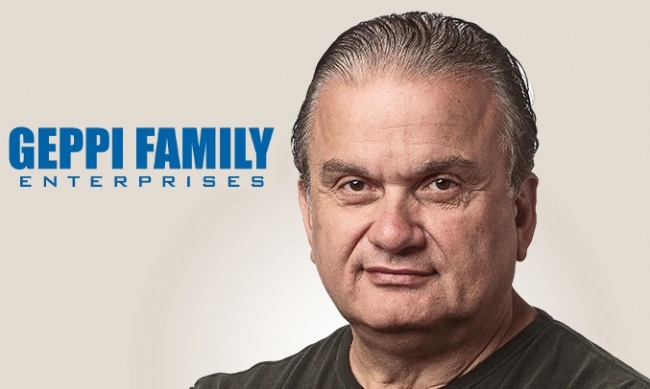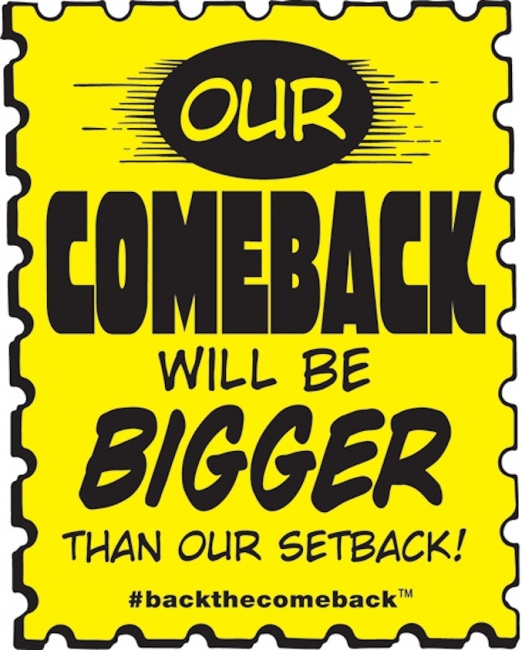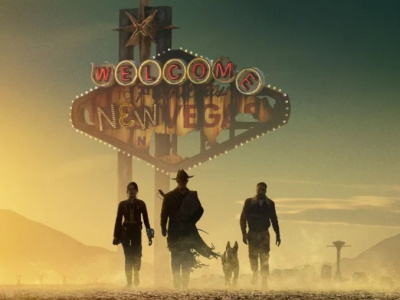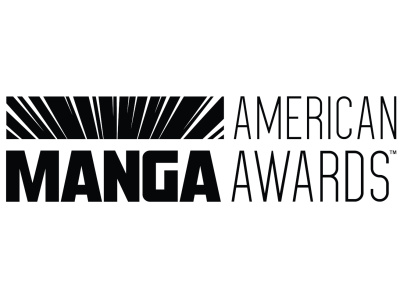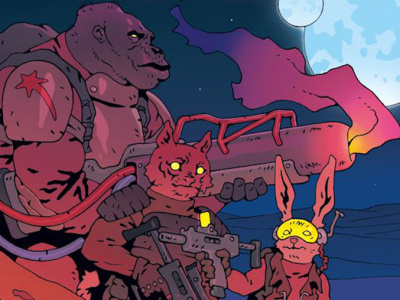ICv2: Tell us about the comeback campaign that you've got planned.
Steve Geppi: We're excited about that. We came up with a slogan that says, "Our comeback will be bigger than our setback." It was my son Josh's idea to utilize, effectively, a cross between the Comics Code Authority stamp and the Marvel Value Stamp. The slogan, of course, is the driving force.
If you recall, back in the 50s, when the government wanted to regulate, [comic publishers] avoided it by having a self‑regulatory thing called the Comic Book Authority. Even though they all competed, they all had that in the corner to make them in some ways uniform. There's going to be a time, particularly in the back issue market, when people are going to look at this period, and whatever they call it (the pandemic period, the coronavirus period, or COVID‑19), there'll be a certain collectible nature to that. Even aside from that (that's like a bonus round), I'm thinking that it will be a good way to drive people to the stores so you can clear the checklist: "If you want to have the complete pandemic period of comics, here's what you've got to have."
It'll get some people to maybe sample other companies that they might not otherwise buy. That's one of my fun parts of this. [Dark Horse CEO] Mike Richardson said, "I'm on board. The only thing we have to qualify is you’ve got to ask guys like Frank Miller if they have a creator‑owned book if they'll do it." Either way, whether some do it or some don't, he's going to do it, it might not be on all the books (I'm hoping it will be). And BOOM! and Dynamite, and Image. I talked to [Image Comics President] Todd [McFarlane], and Todd is going to talk to the [other Image partners] and [Image Publisher] Eric [Stephenson] about it. If we could get Marvel and DC, that would be wonderful. Then we'll have all the big guys, and hopefully as many others will follow.
I've done a video that's going to be released on Wednesday. It's a challenge kind of a video, where we're talking about Back the Comeback. In my video, I'm challenging five people to do a video of their own challenging their friends to do the same. Hopefully, we can (like the Ice Bucket Challenge) get them to post either a video like the one I'm doing and/or a photo of them supporting their favorite store, whether it's their favorite comic book store or game store, and directing them to go also to the website (that will be backthecomeback.com), and also to use the hashtag of #BacktheComeback. What I'm hoping to do is to get not only our industry (and when I say our industry, I don't just mean comics, I mean gaming, whatever else is pop culture) and the world at large, to shine a spotlight on what we're doing.
If in a perfect world, we get this thing to go viral, we could take over a little bit of our version of the Internet with people doing this. They'll be able to buy a T‑shirt, for example. There's a black shirt, so it works perfect with the yellow on black. It says the slogan in the middle of the stamp. People can buy a shirt, and all the money for the shirts will go to helping the comic book stores and the game stores to get them through this period. It'll be administered through charitable foundations like Binc and the Jack Vasel Memorial Fund, the Comic Book Legal Defense Fund.
The bottom line is, there's a series of different things. We're going to do a charity auction. I'm going to donate $50,000 worth of products, serious, great collectibles that people would love to have, and I’m challenging other people to do the same.
I'm going to try to leverage social media and excite the consumers and the retailers. We feel that's going to be a great thing.
Another thing we're doing is my idea. When the shipment comes in on May 20, rather than just be, "OK, we're back to work, and there's a box lands at my store like normal," we're going to make the box have a big sticker on it to say, "Back the comeback," that logo. When they open the box, there'll be a letter from me with a whole detailed outline of how they can help and participate, encouraging them to do videos and to do pictures to get everybody to share as many places on social media and otherwise that they can so that this becomes an event that everybody rallies around.
Early indications from the stores that have already started to reopen is that customers are coming back, the collectors are excited, and we want to play off that momentum, and not just for a week or two, but at a minimum through the end of the year.
We're real excited (as you can tell from me) about it. There'll be in‑store promotions. A lot of publishers have already agreed to participate.
The biggest question we have is that there's going to be some percentage of stores that will be open for walk‑in traffic; some stores will be open for just curbside or shipping; some stores won't be able to be open at all. How do you manage what you hope will be a national campaign when New York, California, Illinois, Michigan, they're all still going to be shut down at the time that you're beginning this?
As I said, the campaign is designed to run throughout the year. Hopefully, it'll all be open by then. In the interim, for those who have, let's say, curbside, posters in the window, their website, whatever forms of communication that they have with their consumers as well as whatever we can muster up in the media.
Hopefully, we'll get some good TV coverage, we'll get some Internet coverage, we'll get radio coverage. We're going to, as best we can, make consumers aware through all the various fractured versions of retail that are coming about, to be able to know what's going on.
Let's say a store in California isn't open, but they can have something in their window or something on their website. Or when they pick up their stuff at the curbside, they're going to get something that's going to remind them of what's going on and make them feel a part of it, until they get to the point where they can literally come into the stores and enjoy the whole, full monty of what we're doing.
The auctions and all those other things, there’s many, many ways [to participate]. I'm going to reach out to other auction companies, too, to see if they can participate in some way, and try to make that number that's being generated bigger. Thanks a lot to Jim Lee's drawings and other things, [Binc has] administered $950,000 already (see "Binc Distributing Over $950,000 to Comic Stores"). We feel that it's a team effort. Everybody, even if you can only contribute a little bit or a lot, with everybody on board and feeling unified as one industry, I think we can do it.
But that's a valid point. Obviously, there's going to be certain states that are going to be slower to get on board, but that doesn't mean they can't participate in the meantime to the degree they can. We're going to encourage them to do it.
Does this apply to Alliance customers as well?
Absolutely. The wording is designed to say "comic book and game stores." This is across the market. It segues into what I'm trying to do overall. As you know, all these years, I've owned all these different companies. Of course, Diamond has always been the biggest of all of them, Alliance is right there with it on the game side, Diamond Book Distributors, and Diamond, UK. What we're doing under the auspices of Geppi Family Enterprises is I'm trying to create a unified front of the collective companies, whether big or small, that are all a part of the driving entity called Geppi Family Enterprises that's designed to help on whatever level we can.
I own the Comic Book Price Guide; we've got an auction house; we've got a toy company; we've got Mylar. We've got a variety of things, and I'm going to try to leverage that in the minds of not only my employees but the industry as a whole to not only look at it as Diamond, that's hard to avoid, but to look at it as (not for my ego's sake but I don't know what else to call it) Geppi Family Enterprises, as an industry mover, somebody that can affect the retailer, so even if you're a retailer that, let's say, doesn't carry new comics, which believe it or not, there are some, then you might be somebody that's big in the back issue market. The Overstreet Price Guide's a factor for you, or you buy supplies and you need Mylar.
We want to show that we're contributing at every level that's important to retailers, because they have other aspects of their business that goes beyond just new products.
As we understand it, you’re going to do the auction in July, August, in that timeframe. Why then instead of now? The need is definitely there now, although it'll probably still be there in July and August. Why did you decide on that timing?
It's twofold. One is to hopefully believe that more if not all of the stores will be open by that period. It also takes some time. We don't want to hodgepodge it and not get as many items as we need or want. The goal is that the number that we raise will be a big one. The more time we have to try to solicit consignments and get help from the consignors and proselytize the fact that there will be an auction, and that as many bidders as possible can come on board, that gives us enough lead time.
Keep in mind, in the interim, we've got all these other things going on. Hopefully, one of those things, like getting the stamp on the upper right‑hand corner of the comic books, will also be in play by then. Remember, publishers need lead time. That's why we had to get some verbal commitments early. We know, as soon as they start printing again, we want it to be at the earliest possible moment. In my perfect world, we've got the books that are already printed that can't anything be done about it. Maybe some are in process, but maybe it's a little too late. But as soon as we can get those books that have those on it, and this auction's starting to occur, there'll be this collective presence of the logo and of the slogan so it'll be easier to get people on board.
One general question is the backdrop for all this. We know Diamond did a survey, but don't know if Alliance did. We’re curious what your understanding is of the state of the retailers out there.
When we filled out our payment plan to the vendors that was designed to pay them 25 percent of the invoices for the books that we've already received, and then the 75 percent was to be paid out over the following 13 weeks so that everybody gets paid in full even if we didn't ship another book, the survey was tied to that plan. We didn't want to project anything until we had a feel for where the retailers were and where we expect them to be. In addition to finding out about where they were and their current state of mind, we asked them questions about their projections. When we finally got around to the Final Order Cutoffs, we had budgeted a certain expectation of a shortfall or a shrinkage. To our delight, the numbers have come in stronger and, in some cases, significantly stronger [than the projections based on the surveys, see "First Post-Shutdown Orders ‘Better Numbers than We Thought’"]
My expectation here is that a great percentage of the sales in the comics industry and non‑returnable world are pre‑sold, in a sense. You have an expectation of your customer base. If you're ordering 100, it's pretty safe to say (unless you're in a super high‑traffic place where you don't do subscription service) that a high percentage of your sales are for pre‑orders, so to speak, or expected subscription orders. I think what's happening is the retailers who were asked to reset their numbers back to zero and start up, they are actually already automatically ordering a high percentage of what they would have ordered for subscribers. Maybe, if anything, they've cut back on their rack sales expectations if they don't know who's going to walk in off the street or how many.
We budgeted perhaps a lower percentage without taking all that into account. When the retailers actually sat down and put pencil to paper, they were ordering far higher than we expected. As a result, my prediction, for what it's worth, is they're going to probably sell out pretty quickly of the orders they ordered because they are being conservative, and hopefully, we'll be able to back them up with some significant reorder service, because I've got a hunch it's going to be a frenzy at first. Maybe this is a bad analogy because it's a different world, but if you look at salons, where people haven't had their hair cut, their nails done, or their pedicure, they're going to be swamped because people who haven't had a chance to do it on their own are going to need it. The difference, and I've mentioned this on the air a couple times, between us and restaurants, sad to say, is the people ate all those two months at home. They're not going to go back and buy those meals again. Whereas we have a pent‑up demand for products that maybe didn't come out or were held back but are still wanted and still unfulfilled. That's where that is.
There's even stores that aren't going to be open that still were covering subscribers. I don't know what arrangement they have, where they might have said to their customers, "Look, do you still want the books?" Keep in mind this is all about the publishers, that communication. The publisher needs to know from us. We need to know from the retailer. I've been encouraging the retailers, to the degree they can by phone, email, or text, to solicit their consumers to get an idea. That's why we bought an extra week on the FOCs. We wanted to give the retailers a chance, in whatever form they could, to survey their customers and get an idea of what kind of commitments they're getting.
If you're DCBS, our new competitor, and if you look at their terms, some of their customers only get the books every two weeks or every month. It's by design, by choice. Maybe it's a freight consideration.
There are people who maybe aren't those shipping customers, but behave similarly. They come in the store every couple weeks or every month. "We know I'm not going to come in every week, anyway, so just bag them up. I don't want to miss an issue." Hopefully, that'll be part of that.



